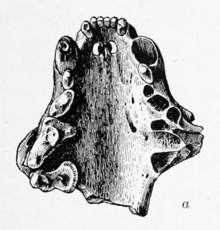Our website is made possible by displaying online advertisements to our visitors.
Please consider supporting us by disabling your ad blocker.
Sea mink
| Sea mink Temporal range: Late Holocene
| |
|---|---|

| |
| Palatal aspect of the skull from the type specimen | |
| Scientific classification | |
| Domain: | Eukaryota |
| Kingdom: | Animalia |
| Phylum: | Chordata |
| Class: | Mammalia |
| Order: | Carnivora |
| Family: | Mustelidae |
| Genus: | Neogale |
| Species: | †N. macrodon
|
| Binomial name | |
| †Neogale macrodon (Prentiss, 1903)
| |

| |
| The sea mink was found in the hub Gulf of Maine area. | |
| Synonyms[3][4] | |
|
List
| |
The sea mink (Neogale macrodon) is a recently extinct species of mink that lived on the eastern coast of North America around the Gulf of Maine on the New England seaboard. It was most closely related to the American mink (Neogale vison), with continuing debate about whether or not the sea mink should be considered a subspecies of the American mink (as Neogale vison macrodon) or a species of its own. The main justification for a separate species designation is the size difference between the two minks, but other distinctions have been made, such as its redder fur. The only known remains are bone fragments unearthed in Native American shell middens. Its actual size is speculative, based largely on tooth remains.
The sea mink was first described in 1903, after its extinction; information regarding its external appearance and habits stem from speculation and from accounts made by fur traders and Native Americans. It may have exhibited behavior similar to the American mink, in that it probably maintained home ranges, was polygynandrous, and had a similar diet, though more seaward-oriented. It was probably found on the New England coast and the Maritime Provinces, though its range may have stretched further south during the last glacial period. Conversely, its range may have been restricted solely to the New England coast, specifically the Gulf of Maine, or just to the nearby islands. The largest of the minks, the sea mink was more desirable to fur traders and became extinct in the late 19th or early 20th century.
- ^ Helgen, K.; Turvey, S.T. (2016). "Neovison macrodon". IUCN Red List of Threatened Species. 2016: e.T40784A45204492. doi:10.2305/IUCN.UK.2016-1.RLTS.T40784A45204492.en. Retrieved 14 March 2022.
- ^ "Neogale macrodon. NatureServe Explorer 2.0". explorer.natureserve.org. Retrieved 3 January 2023.
- ^ "Neovison macrodon". NatureServe Explorer. Retrieved 13 July 2017.
- ^ Wozencraft, W. C. (2005). "Order Carnivora". In Wilson, D. E.; Reeder, D. M. (eds.). Mammal Species of the World: A Taxonomic and Geographic Reference (3rd ed.). Johns Hopkins University Press. p. 619. ISBN 978-0-8018-8221-0. OCLC 62265494.
Previous Page Next Page




